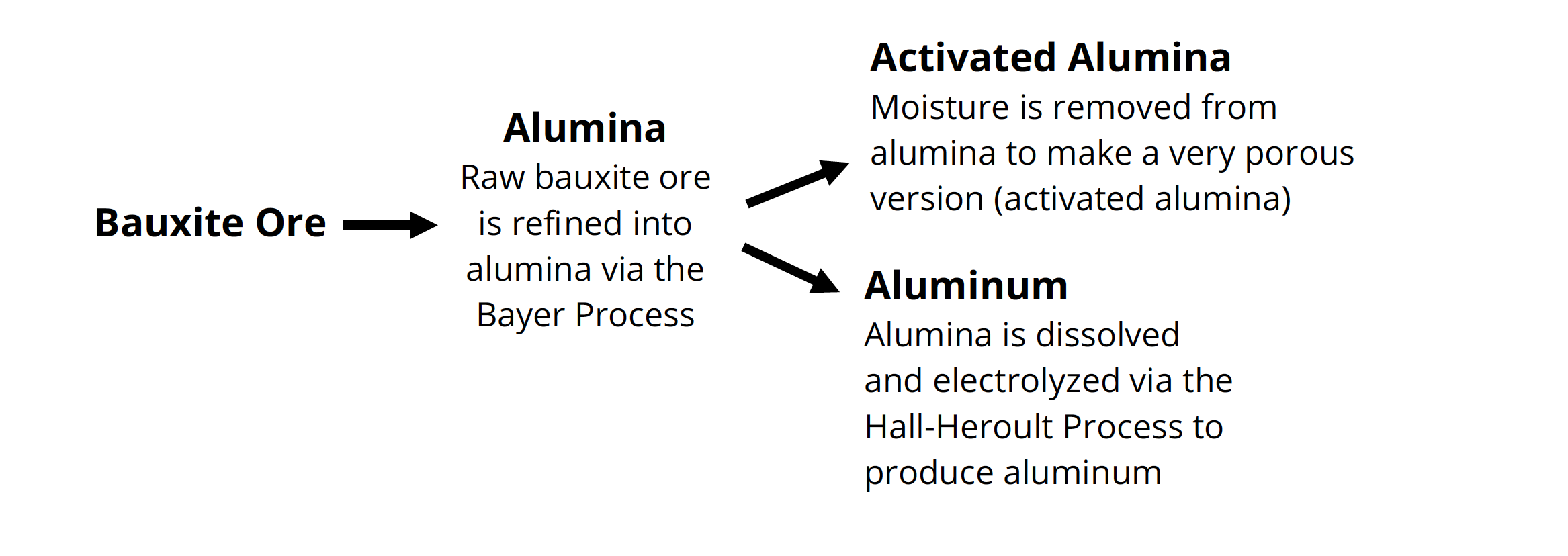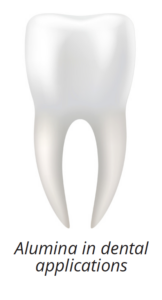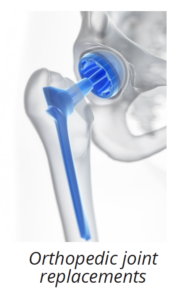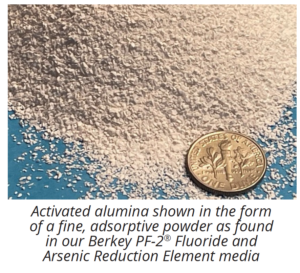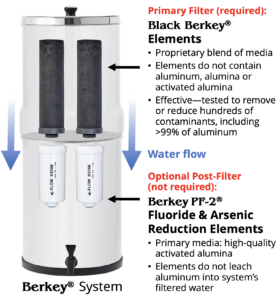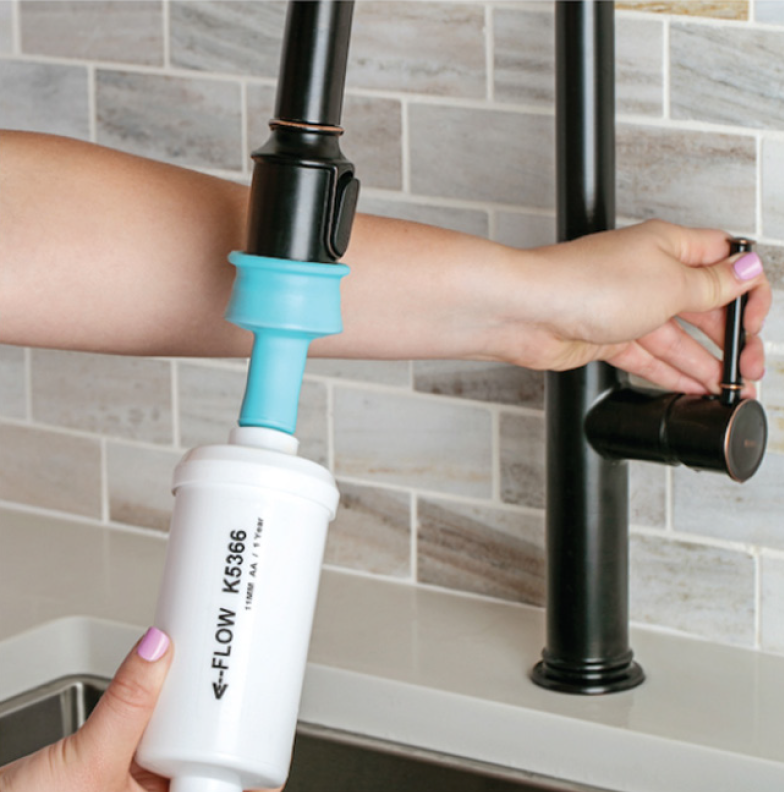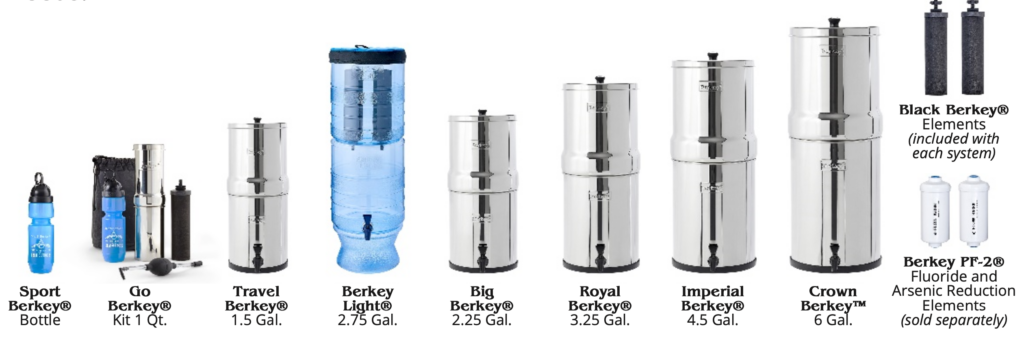Activated Alumina and Aluminum are Not the Same, and Why You Need to Know the Difference.
Tap water quality is a major cause of concern for many consumers who are looking for ways to reduce the numerous contaminants that their drinking water may contain.
If fluoride is one of the main contaminants with which you are concerned, you may see the terms “aluminum”, “alumina (aluminum oxide)” and “activated alumina” being used interchangeably on different websites or social media posts. Sometimes this is due to innocent misunderstanding by uninformed individuals casually reviewing water filtration systems. But sometimes, mixing up the three terms and providing blatant misinformation occurs intentionally in order to create doubt and to discredit legitimate products (such as our time-proven Berkey PF-2® Fluoride and Arsenic Reduction Elements) for the purpose of marketing their own water filtration products whether they sell directly or are paid commissions as affiliates when people purchase a product by clicking on links in their articles or links listed in the comments sections of their videos.
The aim of this article is to set the record straight regarding irresponsible and false claims that some alumina-based fluoride reduction filters, such as ours, leach aluminum back into filtered water—and to help you separate fact from fiction when it comes to researching water filter systems.
While aluminum can pose health risks, alumina and alumina oxide are inert and their properties are as different from aluminum as chlorine is from sodium chloride (table salt). First, we’ll examine the differences betweenaluminum, alumina (aluminum oxide) and activated alumina, which are terms that sound very similar, but are absolutely different materials in their composition and use. Next, we’ll answer the question, “Do Berkey® systems leach aluminum into the water they are supposed to be treating?”. We’ll also take a look at the limitations of standard aluminum testing protocols and why you should properly prime Berkey PF-2® Fluoride and Arsenic Reduction Elements to flush away traces of alumina fines, which may cause water to appear cloudy, affect taste, or be detected by a TDS meter (causing unnecessary alarm).
The Differences Between Aluminum, Alumina (Aluminum Oxide), and Activated Alumina
Sources
Aluminum, alumina and activated alumina are  derived from bauxite ore by utilizing several intricate processes. Bauxite ore is the source of most of the world’s aluminum, with the largest natural bauxite ore reserves being found in Guinea, Australia, Vietnam, Brazil, Jamaica, Indonesia and China. In addition to aluminum, bauxite may contain silica, iron oxide, and other impurities in smaller amounts.
derived from bauxite ore by utilizing several intricate processes. Bauxite ore is the source of most of the world’s aluminum, with the largest natural bauxite ore reserves being found in Guinea, Australia, Vietnam, Brazil, Jamaica, Indonesia and China. In addition to aluminum, bauxite may contain silica, iron oxide, and other impurities in smaller amounts.
Production Processes
To see how aluminum is produced from bauxite ore, here is a very simplified overview of the complex processes involved:
- To begin the process of extracting aluminum from bauxite, the ore must be refined into alumina. This is done by mixing bauxite with a caustic soda and subjecting it to specific heat and pressure levels (also known as the Bayer Process). This produces alumina (aluminum oxide), a stable, non-toxic compound used in many consumer products.
- To make activated alumina, moisture is removed from alumina by subjecting it to high temperatures, making it very porous and suitable for water filtration and many other purposes.
- To obtain aluminum, the element (aluminum) is separated and extracted from alumina via the Hall-Heroult Process (a complex smelting method in which alumina is dissolved in electrolyte at over 1,500o Fahrenheit and electrolyzed, or subjected to high-voltage electric current). The resulting molten form of refined aluminum can then be cast or processed for use in the production of countless consumer products used every day around the globe
Now that we’ve looked at their origins and a basic overview of how they are produced, let’s examine aluminum, alumina and activated alumina in more detail:
Aluminum
Aluminum is the earth’s most abundant metal and third-most abundant element. It constitutes about 8% of the planet’s crust, exceeded only by oxygen (46%) and silicon (28%). It occurs naturally in the soil, water, and even the air we breathe (in minuscule amounts).
Aluminum is reactive and is never found in raw form; rather, it is found in compound form such as or potassium aluminum sulphate or aluminum oxide (which must be further refined to release pure aluminum). Pure aluminum is soft and relatively weak (example: aluminum foil, which is greater than 98% pure aluminum) so it is often alloyed with other elements such as copper, zinc or magnesium to give it greater strength. Aluminum is used as a structural componentin many industries and consumer products, including aerospace, automotive, electronics, building construction, and medical applications as well as many food service products such as pots and pans, aluminum foil, beverage cans and more.

Even though everyday products can leach small amounts of aluminum because aluminum is water soluble, aluminum is generally recognized as safe in the products you use every day. However, many health-conscious people avoid aluminum cooking utensils because of genuine concerns about ingesting aluminum leaching into their food from the use of aluminum pots and pans, aluminum foil, drinking from beverage cans, etc.
Aluminum in Drinking Water: Nuisance Rather than Toxic Threat
Aluminum is considered by the Environmental Protection Agency (EPA) to be a “nuisance chemical”. The EPA has set a non-enforceable secondary maximum contaminant level (SMCL) for aluminum of .05 to 0.2 mg/L. The most noticeable effect of higher-than-SMCL levels of aluminum in your drinking water would be discoloration of the water and a metallic taste. Secondary standards are set for contaminants that are not considered to present a risk to human health atthe SMCL.
Alumina (Aluminum Oxide)
Alumina (aluminum oxide) is a chemically inert (or  extremely stable) organic compound of aluminum and oxygen which is non-water-soluble and does not demonstrate any leaching of aluminum because aluminum is a compound at the molecular level which is protected by a strongly adherent layer of oxide (oxygen). In fact, rubies and sapphires are gemstones composed of an alumina compound known as corundum. And, as you know, these gems do not dissolve in water. Likewise, alumina (activated alumina) does not dissolve in water and is nonflammable, noncorrosive and non-toxic. In fact, it is used in an expansive range of everyday products.
extremely stable) organic compound of aluminum and oxygen which is non-water-soluble and does not demonstrate any leaching of aluminum because aluminum is a compound at the molecular level which is protected by a strongly adherent layer of oxide (oxygen). In fact, rubies and sapphires are gemstones composed of an alumina compound known as corundum. And, as you know, these gems do not dissolve in water. Likewise, alumina (activated alumina) does not dissolve in water and is nonflammable, noncorrosive and non-toxic. In fact, it is used in an expansive range of everyday products.
Alumina has been widely used in medical applications for decades. It has excellent biocompatibility (suitable for use inside the human body) and has been proven to be safe for dental implants, orthopedic joint replace- ments and more. Alumina is also utilized in products that go on the outside of the body as well, being used as an abrasive, anti-cakingagent and opacifying agent in cosmetics such as sunscreen, blush, lipstick and more.
It is important to note that there are no EPA guidelines that limit the amount 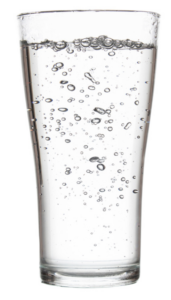 of alumina that can be present in drinking water. Alumina’s proven track record for safe use on (and inside) our bodies begs the question: if alumina (aluminum oxide) could leach aluminum into the body (and do harm, as some would claim), why has it been used without adverse effects in medical and dental applications for years and years?
of alumina that can be present in drinking water. Alumina’s proven track record for safe use on (and inside) our bodies begs the question: if alumina (aluminum oxide) could leach aluminum into the body (and do harm, as some would claim), why has it been used without adverse effects in medical and dental applications for years and years?
Activated Alumina
Activated alumina is a powerful desiccant used in many applications, as well as the industry media standard for removal of fluoride, arsenic and more from drinking water. Activated alumina has been used for the removal of fluoride from drinking water since the 1930s, and is still one of the most common, safe, efficient and cost-effective media used today in both municipal water treatment systems and smaller household-type systems. In fact, the activated alumina market is estimated to be worth $1.5 billion by 2026. According to the EPA, activated alumina is also effective at reducing other contaminants from drinking water such as arsenic, sulfur, selenium and even uranium.
The Proven Safety of Activated Alumina
Activated alumina is made by heating and dehydrating alumina so that it becomes porous and highly adsorptive. Activated alumina’s properties allow it to efficiently adsorb fluoride, arsenic, selenium and other contaminants into its microscopic pores. Instead of the contaminants becoming trapped inside the media’s pores like a sponge through the process of absorption, activated alumina uses adsorption to cause the contaminants’ ions to actually bond to or “stick to” the surface of activated alumina—like metal to a magnet.
2006 European Safety Authority Study
In 2006 the European Food Safety Authority (EFSA) published their “Opinion of the Scientific Panel on food additives, flavourings, processing aids and materials in contact with food (AFC) related to the safety in use of the activated alumina treatment for the removal of fluoride from natural mineral waters”.
Their study concluded, with specific guidelines fulfilled, that:
- The treatment of natural mineral water with activated alumina is suitable for the intended purpose of removing fluoride from natural mineral water.
- Fluoride removal from natural mineral water by means of filtration through activated alumina does not pose a risk to human health.
You can read the study here.
So, you can see, there is a vast difference between aluminum, alumina and activated alumina. To recap:
- Aluminum is an important structural component of the products we use every day, including food and beverage applications. It can leach small amounts of aluminum because aluminum is water soluble.
- Alumina (aluminum oxide) is an inert, organic, biocompatible non-toxic compound of aluminum and oxygen (outer oxide layer) which is non-water-soluble and does not demonstrate leaching of aluminum.
- Activated alumina, derived from alumina, is also non-toxic, non-water-soluble, does not demonstrate leaching of aluminum and has been proven safe and effective for decades as an industry-standard medium for removing certain contaminants from drinking water, including fluoride.
Do the Filters of a Berkey® System Leach Aluminum into the Water It’s Supposed to Be Treating? (The Answer is “NO”).
Competitors and detractors with various agendas have claimed that Berkey® systems (and other alumina-containing filter systems on the market) are designed with filter media that actually adds aluminum into the filtered water. This is a false and misleading claim, and is simply not true.
Therefore, it is important to understand the purpose and general composition of each Berkey® element:
(main system filters, required)
Black Berkey® Elements are composed of a proprietary formulation of multiple high-grade media types. Black Berkey® Elements have been tested to address over 250+ typical contaminants found
in tap water and other freshwater sources. Black Berkey® Elements
do not contain any alumina, and
do not add aluminum to water; in fact, third-party accredited lab tests have reported that Black Berkey® Elements reduce aluminum by >99%.
2. Berkey PF-2® Fluoride and Arsenic Reduction Elements
(optional post-filter—not required to use system, and must be used in conjunction with Black Berkey® Elements)
Berkey PF-2® Fluoride and Arsenic Reduction Elements provide an optional, added layer of protection for those concerned about fluoride, arsenic and certain other specific contaminants. Activated alumina is a key component of Berkey PF-2® Fluoride and Arsenic Reduction Elements. Activated alumina is used in these elements due to its adsorptive properties and long track record of outstanding performance.
Why Do Some Drinking Water Tests Show Aluminum In the Water After It Has Been Filtered?
The limitations of standard aluminum testing protocols cause confusion! It is important to note that Berkey PF-2® Fluoride and Arsenic Reduction Elements do not contain pure aluminum (which, as explained above, is different than alumina).
However, the presence of tiny amounts of harmless alumina (fines) in water treated by Berkey PF-2® Fluoride and Arsenic Reduction Elements may cause the water to test positive for aluminum, even though pure aluminum is not contained in the Berkey PF-2® Fluoride and Arsenic Reduction Element’s media. This is a result (in more scientific terms) of the method utilized by laboratories to test for metal contamination in water. In such testing it is first necessary to break apart the oxidized metal ions from their oxygen component. After that, an ion count is taken. This also applies to aluminum oxide. The oxygen is separated from the aluminum molecules so that the aluminum ions can then be counted. It is for this reason that laboratory tests do not distinguish between aluminum oxide and pure aluminum in their testing procedure. In other words, such tests generate a false positive by separating the aluminum ions from the oxygen, and then they report the amount of aluminum ions in the sample (even though pure aluminum is not present in the original sample water).
A Word About TDS Meter Readings with Berkey PF-2® Fluoride and Arsenic Reduction Elements Installed in Your System
People often use TDS meters, albeit erroneously, as a measure of a water’s overall suitability for drinking. TDS meters simply cannot tell you if your water is safe to drink. Some detractors of our systems go a step further, and claim that TDS readings are actually higher after they install a set of Berkey PF-2® Fluoride and Arsenic Elements than before they installed the elements (which may be true)— but incorrectly assume that the higher readings are due to PF-2® filters adding aluminum to the water (which, again, is completely untrue).
To clear up this misconception, it is imperative to understand two things: first, what a TDS meter measures (and why it is not a reliable—or accurate—instrument for determining drinking water quality); and second, what Berkey PF-2® Fluoride and Arsenic Reduction Elements are composed of.
- What a TDS Meter Can—and Can’t—Tell YouTDS meters only measure the levels of total dissolved solids (with ions
that are charged) such as minerals in your water (many of which are known to be beneficial to your health) and heavy metals (which may be bad for you), but TDS readings do not tell you which dissolved solids (good or bad) might be present.Because a TDS meter only detects charged ions, a TDS meter cannot measure uncharged contaminants. Uncharged contaminants can include toxic chemicals, petroleum, pharmaceuticals, potentially lethal biological pathogens, and other certain typical contaminants that might be present
in your water. Therefore, TDS meters cannot tell you if water is safe to drink or not, and those that advocate for using TDS meters for this purpose are either uninformed or being dishonest in order to sell their products, such as certain pitcher-type water filters that are effective in removing TDS from water but are not effective at removing other important contaminants; or reverse osmosis (RO) systems that strip everything (good and bad) out of the water. - The Importance of Properly Priming Berkey PF-2® Fluoride and Arsenic Reduction Elements Before Use Minute amounts of process dust may be present on Berkey PF-2® Fluoride and Arsenic Reduction Elements after assembly. This is completely normal and the process dust is completely harmless. The dust, which may contain inert, activated alumina (again, not aluminum), may be detected by a TDS meter and cause it to give you an unusually high reading. Properly priming the Berkey PF-2® Fluoride and Arsenic Reduction Elements with water helps flush away excess process dust, and should result in lower TDS readings.
Also, if the elements are not properly purged (primed) prior to use, the presence of the process dust may increase the possibility of turbidity (or cloudiness) in the first few cycles of water. In fact, our testing shows that properly priming Berkey PF-2® Fluoride and Arsenic Reduction Elements several additional times further reduces turbidity in your water (if turbidity is present at all).
Again, to restate two important points regarding concerns (or the lack thereof) about aluminum and alumina, as discussed earlier in this article:
- Aluminum is considered a “nuisance contaminant” per the EPA, and not considered to present a risk to human health at the SMCL (secondary maximum contaminant level).
- There are no EPA guidelines that limit the amount of alumina that can be present in drinking water.
As you can see, it is impossible to avoid coming into contact with aluminum in everyday life—and the overwhelming evidence suggests that aluminum is simply not a significant threat to the average healthy consumer. When is the last time you heard of someone getting aluminum poisoning after eating a baked potato that was cooked in aluminum foil (which is greater than 98% pure aluminum)? Or more relevant to this article, that a boil order was issued for tap water due to an “aluminum outbreak” in a local water supply? Or that an environmental advocacy group was holding a press conference to discuss the problem of aluminum in your drinking water? The answer is most likely NEVER— and that’s our point.
A Final Point About Fluoride
Many people believe fluoride contributes to stronger bones and healthier teeth— while others believe exposure to fluoride in any way is a health hazard.
Many Berkey® Water Systems users around the world choose not to use the optional Berkey PF-2® Fluoride and Arsenic Reduction Elements, as they either do not have fluoride added to the municipal water in their area or country, or are not concerned about fluoride—while others believe exposure to fluoride in any way is a health hazard and prefer to reduce the amount of fluoride in their drinking water.
To give customers a choice regarding fluoride reduction, we developed and offer the optional Berkey PF-2® Fluoride and Arsenic Reduction Elements that can be added to Berkey® systems to reduce fluoride in drinking water.
With all this being said, there remains detractors of our brand which would like you to believe all Berkey® Systems are a scam (regardless if PF-2 filters are used or not)—focusing their attack on their false claim of aluminum being leached into the water from the use of optional Berkey PF-2® Fluoride and Arsenic Reduction Elements, which also unfairly bring into question the performance of time-proven Black Berkey® Elements, which have been independently tested by third-party labs to remove or reduce over 250 contaminants found in drinking water.
It becomes apparent that many detractors of successful brands (such as Berkey®) are in the business of saying bad things about one brand, while using articles load- ed with profitable affiliate links that pay them affiliate fees (money) to promote other brands—a practice we will discuss further in an upcoming article that shows that many detractors are not being objective and clearly have an untrustworthy agenda. The bottom line is that Berkey® water systems are still the mostpopular and trusted gravity-fed water filtration systems available.
Take Control of Your Wallet and Your Drinking Water with a Berkey® Gravity-Fed Water Filtration System
In today’s uncertain world, many people feel that having an effective water filter is more than just a good idea, it’s a must-have!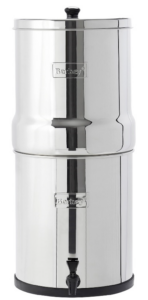 Berkey® systems are designed to meet the specific needs of consumers seeking practical and cost-effective water filtration solutions. Berkey® systems are simple and easy to use and require no electricity, costly installation, tools or plumbing to operate, providing economical, long-lasting water filtration for just pennies
Berkey® systems are designed to meet the specific needs of consumers seeking practical and cost-effective water filtration solutions. Berkey® systems are simple and easy to use and require no electricity, costly installation, tools or plumbing to operate, providing economical, long-lasting water filtration for just pennies
a gallon.
Available in 7 sizes, Berkey® systems equipped with Black Berkey® Elements have been tested by independent third-party labs to remove or dramatically reduce 250+ typical contaminants in water. For consumers concerned about the effects of fluoride in their drinking water, adding Berkey PF-2® Fluoride and Arsenic Reduction Elements to their Berkey® water system adds another powerful layer of contaminant reduction capability.
Berkey® Systems—Trusted by Consumers Worldwide
Berkey® systems are used every day in homes around the world by discerning consumers who trust the quality of Berkey® systems to meet their drinking water needs.
To learn more, or to purchase a Berkey® system, contact your local Authorized Berkey® Dealer today!
For Further Reading
- What is Aluminum Oxide?
- EPA.gov – Secondary Drinking Water Standards: Guidance for Nuisance Chemicals
- If NMCL’s recent test results show that the Black Berkey® Elements reduce Fluoride, then why do I need the Berkey PF-2® Post Filter Elements?
- Black Berkey® Elements Test Results
- Why is it Necessary to Purge the Berkey® Post Filter Elements?


